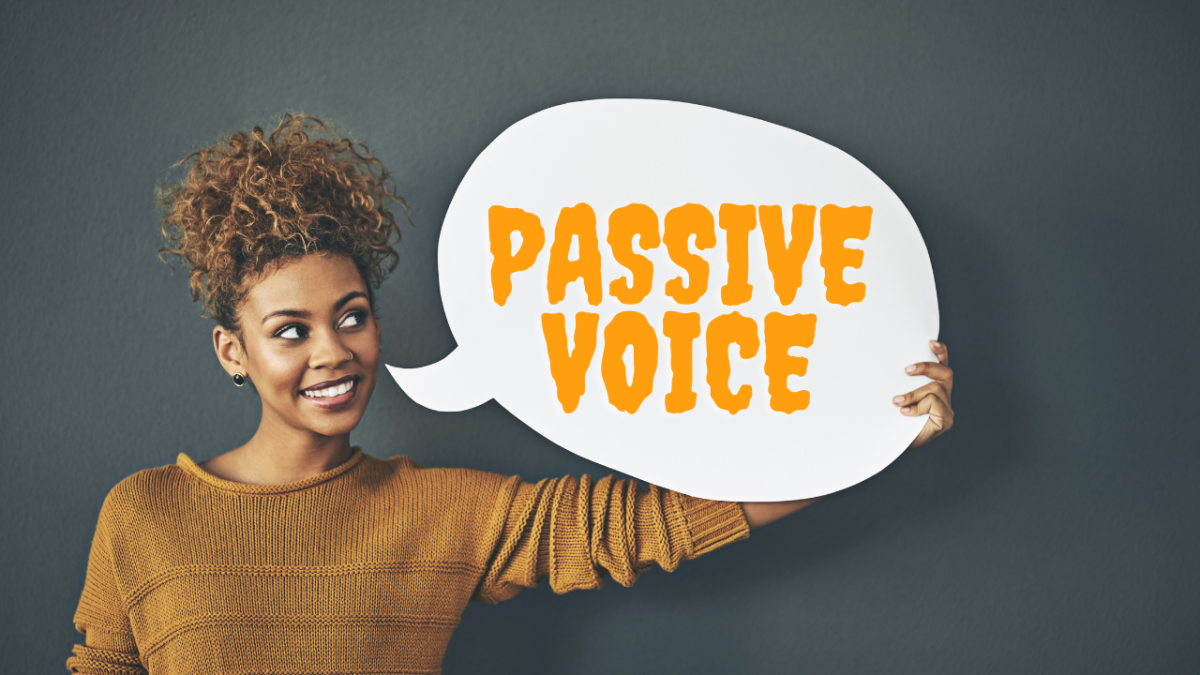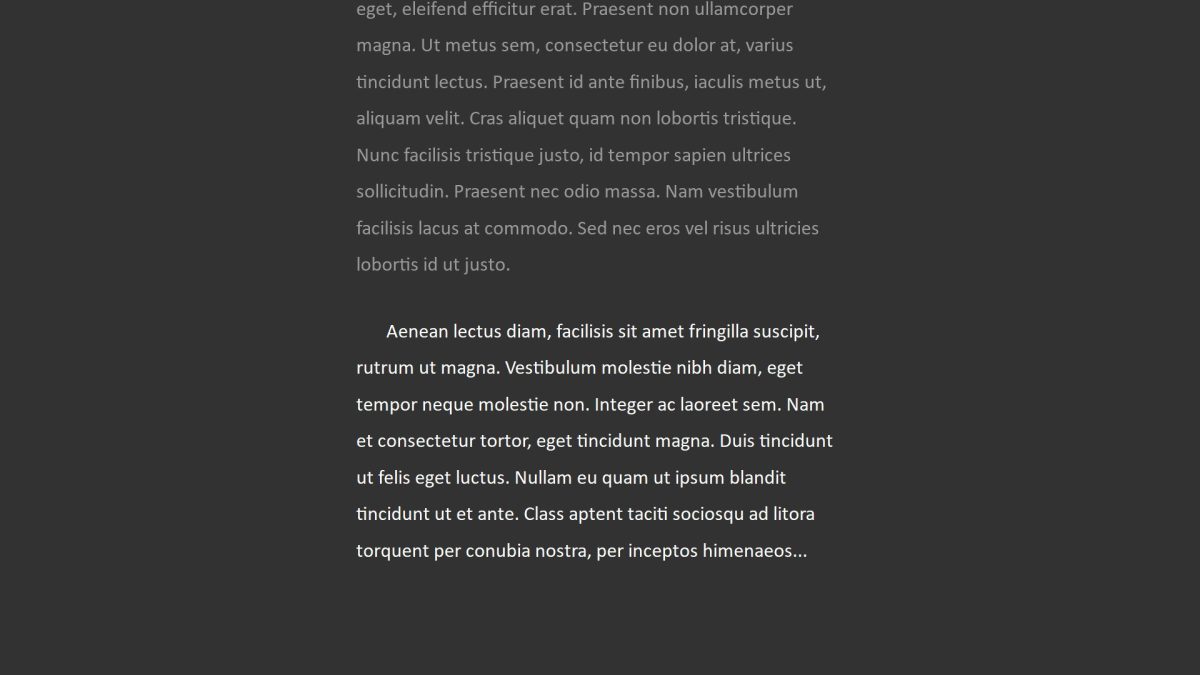Five MORE Pedantic Pointers to Help You Pen More Proper Prose

This article is a continuation of my first hub, "Five Pedantic Pointers to Help You Pen More Proper Prose," in which I transformed my top five greatest "grammar pet peeves" into bits of advice geared towards helping others better their writing skills.
Without further ado, read on for five more nifty tips to follow in order to become an even more astute pen wielder!
#1: Make sure your verbs agree with your subjects
Making sure a sentence's main verb is properly aligned with its subject simply requires you to note whether or not the subject is plural or singular.
For instance, in the phrase, “The feisty cat hisses at the cowardly dogs,” the subject is “the feisty cat,” and the verb is “hisses."
The sentence above is therefore grammatically correct because “the feisty cat” is singular and aligns with “hisses," the singular form of “to hiss."
Obvious, much?
The truth is, it's pretty easy to detect subject-verb disagreements when the subject and verb are close to one another, like in the sentence above.
Things get tricky, though, when prepositional phrases come into play, in the sense that it's much easier to end up accidentally using the wrong form of a verb in a sentence when there’s a long string of them separating the verb from its subject.
Take for instance the phrase:
"The jar of peanut butter sitting on the counter next to the azaleas were difficult to open.”
In this sentence, there are a few prepositional phrases (i.e., “of peanut butter," “on the counter,” “next to the azaleas”) that might keep you from realizing the fact the “the jar” is the subject of the phrase’s main verb (not the azaleas!).
That said the correct form of the verb—in this case, “to be”—is “was,” not “were,” since there is only a single jar that was difficult to open (cross out all those pesky prepositional phrases, and everything becomes clearer!).
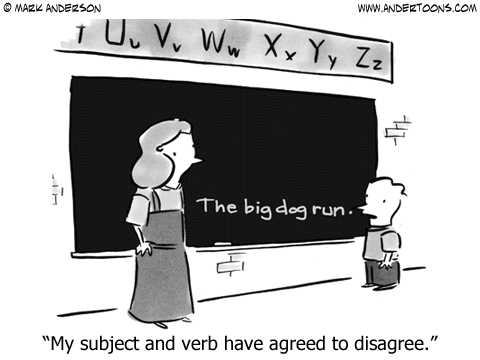
In addition, words that have “every” and “one” denote a singular subject, even though they might imply a large group of people or things (also the word "each," and those that end with "-body," as in "nobody" or "somebody").
For example: “Everyone in the world, young and old, just want to be loved.”
Though the subject—“everybody”—implies that the statement applies to a large number of people, the verb should still take on its singular form (instead of “want to be loved," it should say, “wants to be loved").
Another instance: “Everything on the planet, from the mountains to the seas, is made out of matter” (not, “are made out of matter”).
Lastly, note that events are always singular subjects, even if their titles bear a plural term; for instance: “The 71st Annual Golden Globe Awards was last month,” and “The 2016 Summer Olympics is going to take place in Rio de Janeiro.”
#2: Don’t misplace (or dangle) your modifiers
First off, let’s clarify the meaning of the term “modifier”: In short, it’s a word (adjective or adverb) or descriptive phrase that describes—or modifies—another word (or group of words).
For example: In the phrase, “The green jellybean,” the adjective “green” is a modifier describing the noun “jellybean.”
Here’s a more complex one:
“Lost amidst a sea of shops, the young girl meandered around the mall, searching for her mother.”
In this sentence, the phrase “lost amidst a sea of shops” modifies—or describes—“the young girl.”
That said, when it is unclear what a modifier is supposed to be modifying (i.e., the modifier is not immediately followed by the object that it modifies), a dangling modifier is born.
Take for instance: “Lost amidst a sea of shops, the mall's vast expanse frightened the young girl, who couldn't find her mother.”
Though it’s implied that the young girl is the one who is lost, the structure of this sentence makes it seem as if it's the mall's vast expanse that is lost, not the girl, due to the fact that “the mall's vast expanse”—not “the young girl”—is placed closest to the modifier (“lost amidst a sea of shops”). Ergo, the modifier is left misplaced, or “dangling.”
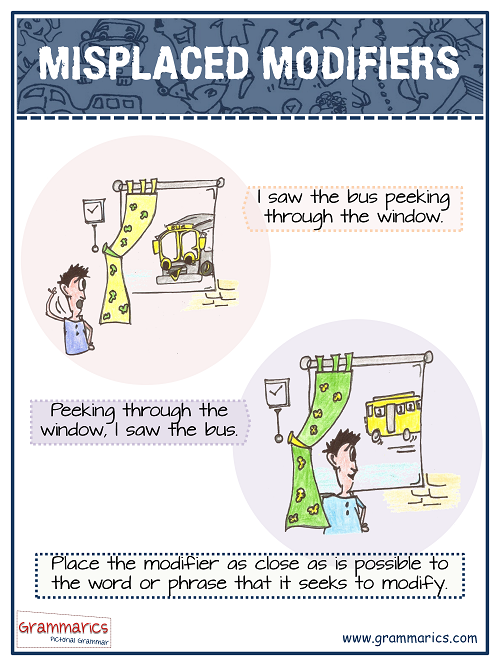
To fix it, we could instead say: "Lost amidst a sea of shops, the young girl, who couldn't find her mother, was frightened by the mall's vast expanse."
Note that this rewording places the modifier's subject right next to it, therefore clarifying its purpose.
Let’s try another, shall we?
“Excited to partake in the annual egg hunt, the thought of Easter thrilled the boy.”
In this sentence, one can assume that the boy is the one who’s excited to partake in the egg hunt; however, due to the way the sentence is structured, it actually seems like “the thought of Easter” is the entity that’s excited to partake in the hunt, not the boy (which clearly makes no sense, since a thought doesn’t have the ability to get excited about anything!).
To remedy this issue, simply place the object being modified—i.e., the boy—immediately after the modifier (i.e., “excited to partake in the annual egg hunt”), and you get:
“Excited to partake in the annual egg hunt, the boy was thrilled by the thought of Easter.”
That way the modifier is no longer dangling, seeing as the thing it’s describing (the boy) appears directly after it.
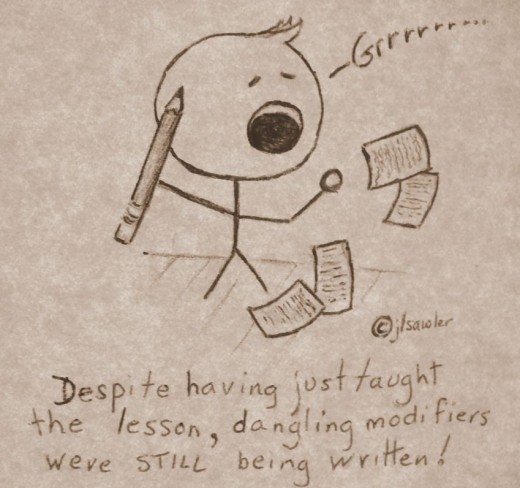
#3: Don't use "as well as" as a synonym for "and"
This isn’t too terrible of an offense, though I think it’s worth mentioning.
When people make lists, they often sub in “as well as” for “and,” especially when the latter is used as a connector within the items of a list.
In truth, using “as well as” in a sentence is kind of like tossing in an afterthought, since the three-letter phrase implies the line that it appends carries less significance than the statements that come before it.
For instance, let’s examine the following sentence:
“I enjoy (reading and writing stories) [item #1 on the list], (cooking and eating food) [item #2], as well as (listening and singing along to songs) [item #3].”
Though you might assume this statement means I enjoy doing all three items equally, the use of “as well as” skews the weight of the statement in favor of the first two on the list. In other words, the phrase unwittingly translates to:
“I enjoy reading and writing stories, and cooking and eating food . . . and oh, I like listening and singing along to songs too, but not as much as I like doing the first two items mentioned.”
What I really meant to say is that I like reading and writing, cooking and eating, and listening and singing, all in equal amounts; I didn’t intentionally put an emphasis on the first two. That said, the sentence should instead read: “I enjoy reading and writing stories, cooking and eating food, and listening and singing along to songs.” All those and’s might seem a bit cacophonous to the ear, but the sentence is nonetheless grammatically sound!
#5: Don't confuse words that may look or sound similar, yet have completely different meanings
It drives me absolutely insane whenever someone confuses terms that are similar in looks and pronunciation, though possess completely different meanings.
Here's to setting the record straight on a few of the most frequently wrongly interchanged terms!
1) Its vs. It's
Its: Indicates something that belongs to "it"; for instance, "Its name is Alice!"
It's: Short for "it is"; for example, "It's a tea cup poodle!"
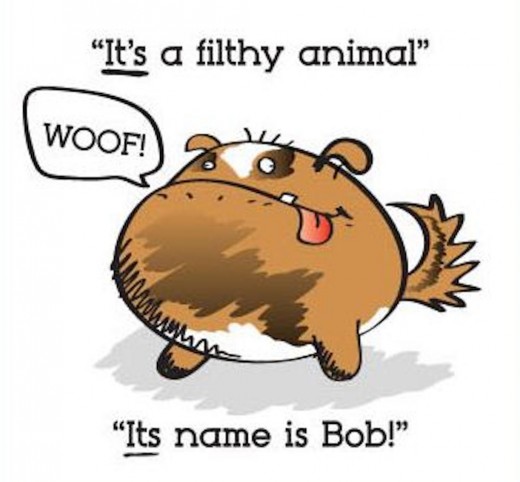
2) Their vs. They're vs. There
Their: The only "possessive" one in the trio, it's the plural form of "his or hers"; for instance, "Those are their cookies, not yours!"
They're: The contraction of "they are," it's the plural form of "he/she is"; for instance, "They're going to be here any minute, so you better put some pants on!"
There: The only one that indicates a location or direction; for instance, "I'll meet you there by the treehouse at midnight," or "I'm headed over there!"
"Since they're going over there for the holidays, their puppy is going to stay with us for a week!"
3) You're vs. Your
You're: Short for "you are," as in "You're funny and lovely."
Your: It indicates possession, as in something that "you" have; for example, "Your ears are funny, but your eyes are lovely."
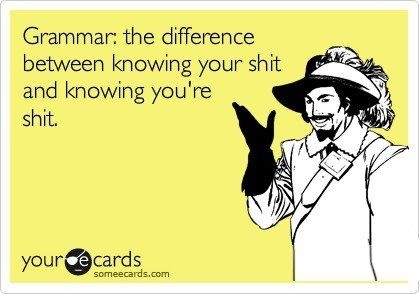
4) Lie vs. Lay
The trick to remember here is that people and animals lie, while objects lay.
As simple as that sounds, it gets a bit more confusing when you begin to deal with past tense, since that's where the confusing overlap occurs ("lay" is a form of both verbs, though in different tenses).
To make things easier to explain without throwing around a whole lot of befuddling terms, I've provided a few examples to illustrate the difference between the two:
To lie (to recline) does not require an object.
Present tense: "The cat lies at the foot of the bed."
Past tense: "The cat lay down on the bed."
Gerund: The cat was lying down on the bed.
Past participle: The cat has lain in the same spot for hours.
To lay (to put, place, or set down), on the other hand, does require an object.
Present tense: I lay the book on the desk.
Past tense: I laid the book on the desk.
Gerund: I am laying the book on the desk.
Past participle: I had laid the book on the desk.
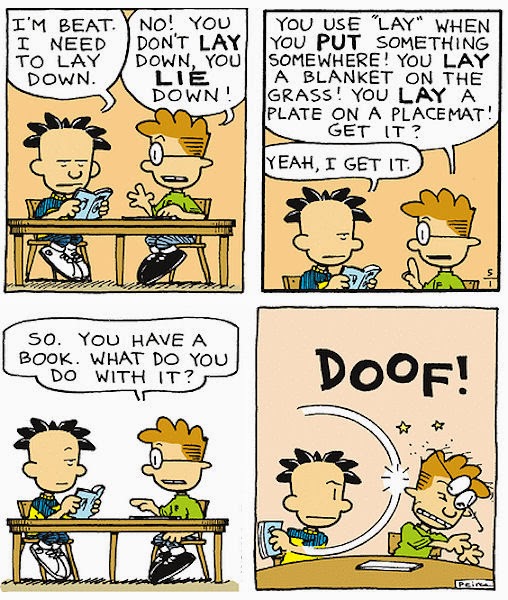
It would therefore be wrong to say, "The cat lays at the foot of the bed," since there's no object in play; if you were to say, "The cat lay the dead mouse at the foot of the bed," however, it would be okay, given that "the dead mouse" (an object) is mentioned.
Bonus bit:
There are no such things as “could of,” “should of,” and “would of.”
You actually mean to say, “could’ve,” “should’ve,” and “would’ve.”
In short, avoid accidentally replacing “have” with the preposition “of”; it’s one of the silliest transgressions to make, in my book. Whoops, you say? I’m sure you could’ve and would’ve, if you’d only known that you should’ve . . . just don’t do it ever again, okay??
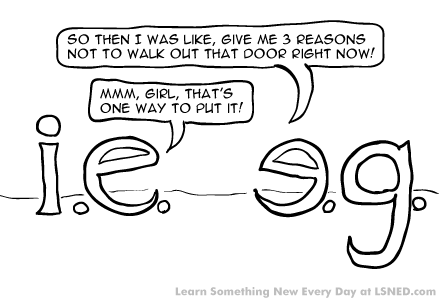
#5: Know the difference between "e.g." and "i.e."
The abbreviations e.g. and i.e. are frequently interchanged, but the truth is, they’re not synonymous!
Here’s the distinction between the two: The former is short for exempli gratia, a Latin phrase that translates to “for example,” while the latter stands for the id est, which signifies “that is.”
It is therefore used to provide further clarification; for instance:
"On Saturdays, I always wear my favorite earrings, i.e., the ones my mom bought me for Christmas."
If the Latin terminology throws you off, just pretend i.e. signifies “in essence” instead, and the difference should become clearer.
Meanwhile, "e.g." is typically followed by a list of examples, like in the sentence:
"I enjoy eating cold foods year-round, e.g., ice cream, fro-yo, and chilled cucumber soup."
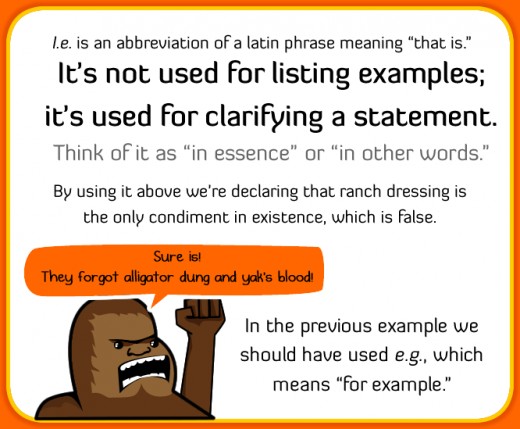
© 2014 Kristin Tablang

